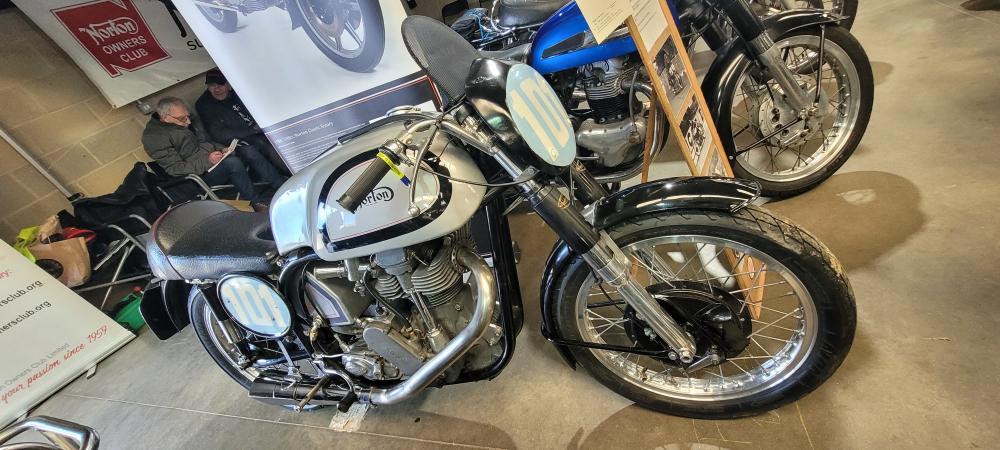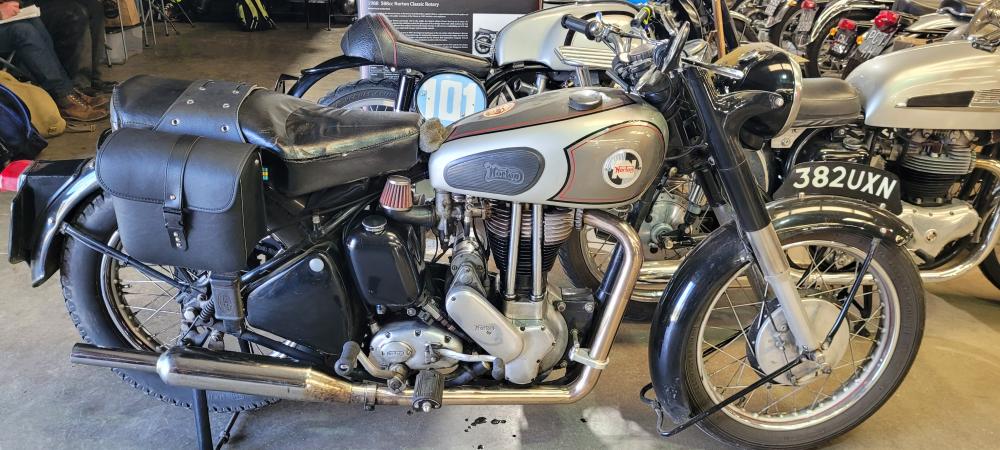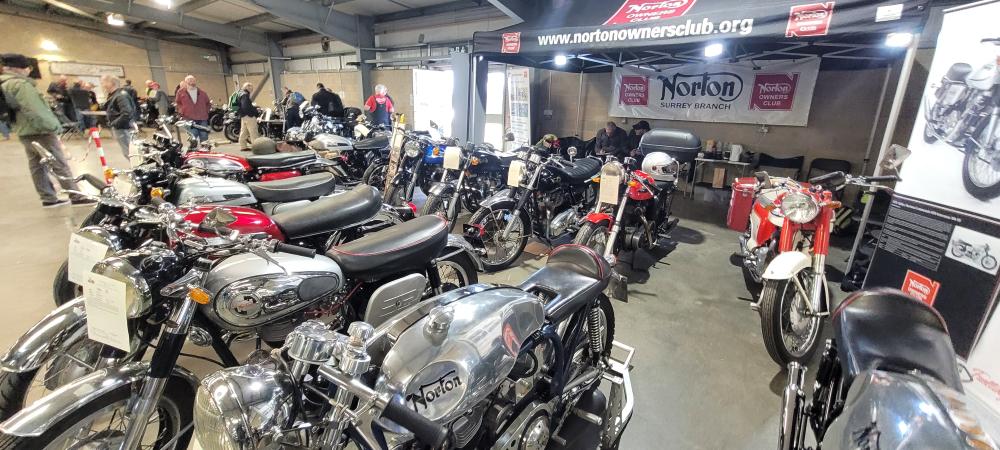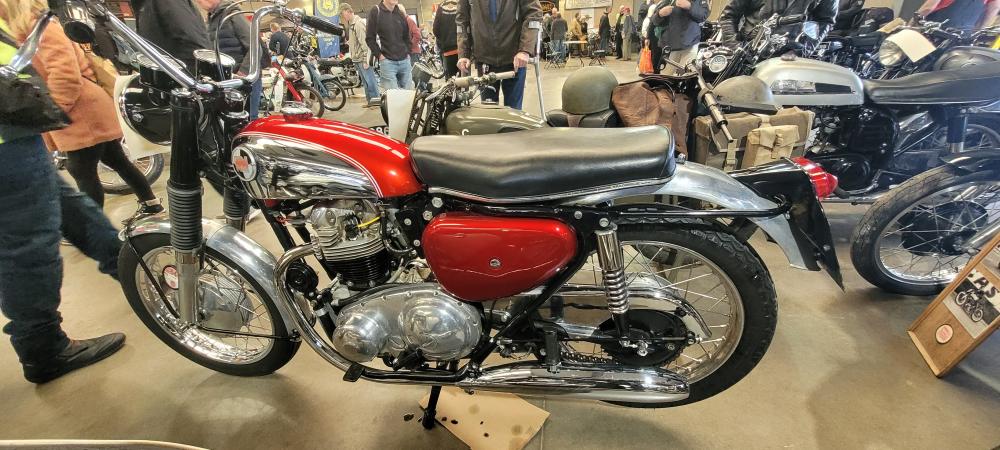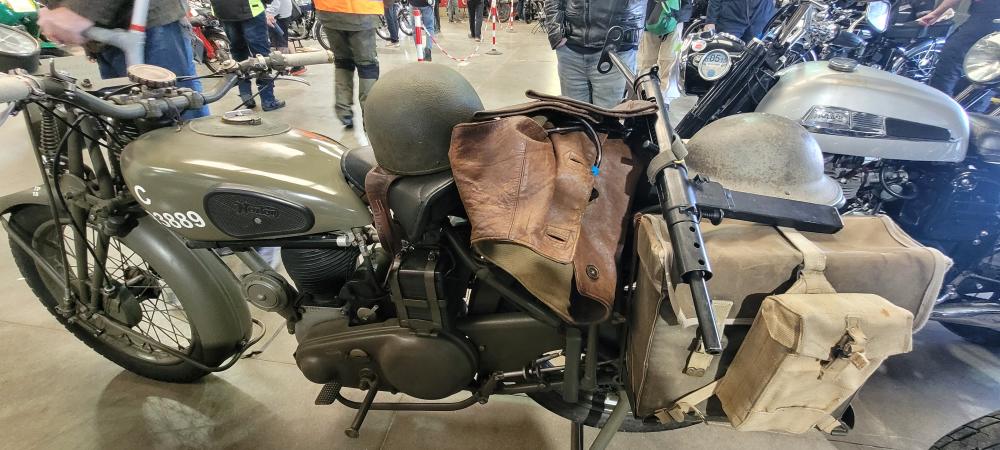A review of correspondence from NOC-L
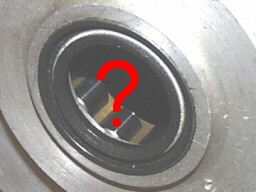
Mixing ball and Superblend bearings
As to the crankshaft bearings, I see little sense in using one ball bearing and one Superblend. The former will hardly allow angular misalignment, whilst the latter will. Since the crankshaft is nearly symmetrical with respect to bearing locations and loading, the ball bearing will fail or wear rapidly, not permitting the Superblend to adjust as intended. I'm aware the 650s and 750s used a ball/roller bearing combination, albeit with a significantly lower compression ratio than Commando pistons. Life expectancy of these bearings was probably less than 40,000 miles (65000 kilometres).
Atlas runs OK with ball and roller bearing combination
I must humbly disagree with Knut in his bearing recommendations. I have personally run an Atlas with a Commando head (that's where the compression is made, not in the pistons) for over 30,000 miles. The Atlas was even run without oil for about 8 miles. It was still going when I sold it several years back and I have no idea how many miles were on it when I got it. The Atlas had the usual ball and roller bearings. The roller bearing problems really became evident when the Combat motor was introduced. Combat motors have a cam that really likes to rev, and that is what causes crankshaft flex. Flex isn't a significant problem with an Atlas cam unless it is run really hard. In that case a ball bearing is still more tolerant of flexing than a normal roller.
Dave Hatch (aef@icx.net) on NOC-L 15th. Apr 1997
Heavy-duty ball race fitted to the timing side
I run two Superblends, but John Hudson has mentioned that a heavy-duty ball race on the timing side is an alternative for people who want the degree of control of the crank endplay that the design intended. This is NOT the pre-Combat setup, which used an ordinary ball race -- the heavy-duty ball race (with notched races to fit extra balls) is almost as strong (and just as expensive) as a Superblend.
Mike Taglieri (miketync@aol.com) on NOC-L 16th. Apr 1997
Atlas vs. Commando pistons & Superblend recommendation
Dave is partially wrong in that Atlas and Commando pistons in fact differ - Atlas ones are concave (i.e., have a depression) while all Commando pistons (the compression ratio varied from 8.7:1 to 10.25:1) are completely flat. Yes, on the Commando they varied the compression ratio by milling off the head. As far as I know, the height of the piston crown did not differ - 850 pistons are approx. 1mm lower than the Atlas/Commando equivalent, but the compression ratio is also lower (8.5:1 vs. 8.7:1 initially). The cylinder head of the 20M3 may have been shaved additionally over the Atlas head - if someone knows for sure, please contribute.
What Dave also says, is that crankshaft flexing is a problem on all Norton engines when run hard. Paul Dunstall confirms this in his tuning notes by recommending bearings to be pegged. He also mentions that in 1969 the factory changed to tighter fitting drive side roller bearings to prevent moving of the outer race in its boss. Note that this modification was made to all 20M3 and 20M3S engines from then on. Bearing problems may not be an acute problem on an Atlas when ridden gently, but in my opinion it's an area of concern. That is sufficient for me to fit Superblends. As a side effect it will alleviate strain on the crankcase as well and thus prevent future cracks.
Knut Soensteby (knut.sonsteby@lhg.hib.no) on NOC-L 16th. Apr 1997
Crankshaft flex reference & Superblend recommendation
|
One of the articles in the NCNOC tech sessions is about crankshaft flex (http://ru486.hypno.com/~norton/farrell.html) which quotes Norton racer and engine builder Mike Farrell to this effect:- "The basic concept, according to Farrell, is this. At top r.p.m., Norton crankshafts flex more than what dual Superblends and what reinforced crankcases will allow. It is better to allow the crank to flex than to try to control it. The best way to accomplish this is to use a Superblend bearing on the drive side and an extra capacity ball bearing on the timing side." |
Andy Holmes (pha59@elec.keele.ac.uk) on NOC-L 16th. Apr 1997
Crankshaft flex
I've been reading some commentary to the effect that two Superblends are far too rigid, and will send the flex through to the crankcases, which will start to suffer as we all know so well. The underpinning of the argument for using one of each is that flex happens, and it's better to take the bullrush approach instead of the oak tree approach. Although I'm not an engineer by training, I must admit to a certain bias towards this argument, particularly since the gentlemen most recently to espouse it has been doing it with allegedly great success for a number of years on his racing Nortons.
John Kula (johnkula@islandnet.com) on NOC-L 16th. Apr 1997
Superblends vs. ball bearings
Before making up my mind on John's information, I would like to read the arguments in original. At the outset, a Superblend is basically a roller bearing which Norton fitted for at least 15 years before starting to use Superblends in serial production (I think this happened in 1973). The alleged rigidity would therefore affect them all. If the quoted racing man fits a heavy-duty ball bearing in the timing side it will have to take a lot of pain and the outer race will most likely twist in its boss. There is also danger of damaging the crankcase. Ball bearings do take up some axial loads though which roller bearings can't take up and will make end float adjustments redundant. However, I don't think that's the point here.
In a recent mail Frank Holden claims that stiffness of the cases goes into the equation. In my opinion, this is wrong - as far as I know, stiffening of the shells was made to prevent cracks, especially in the drive side boss area, and should be assessed independently of the crankshaft bearing theme. The stiffening seems to work fine, especially when the improved Mk111 crankshaft and Superblends are used.
As a side note, serious road racers run the Atlas with a solid (one-piece) crankshaft and the bearing problem seems to disappear. However, the next weak spot soon shows up - cracks around the separation flange of the crankcase. The remedy is to weld in stiffening plates along the flange.
Knut Soensteby (knut.sonsteby@lhg.hib.no) on NOC-L 16th. Apr 1997
Superblends allow for some crankshaft flex
I have to agree with Knut. The whole idea of a Superblend is to allow for a bit of misalignment or flex, whereas a heavy duty ball bearing will not accommodate much misalignment of any degree. It escapes me how combining them to support opposite ends of a flexible crank can possibly do any good at all.
Greg Kricorissian (grkricor@ccs.carleton.ca) on NOC-L 16th. Apr 1997
BSA & Triumph use ball bearings, so why rollers on Nortons?
| Knut Sonsteby opined about Frank Holden's ball timing side main bearing "..... angular realignment of a ball bearing is comparatively small ....." |
I find it pretty hard to believe that the "comparatively small" alignment tolerance of a ball bearing is not sufficient for a Commando timing side. The question it seems to me is whether eliminating the problem of shimming for end float is worth the lesser capacity of the ball bearing.
The undiscussed question is - do Norton crankshafts really flex more than BSA and Triumph twin cranks, and if so why? BSA & Triumph get away with balls and plain rollers just fine, don't they? Is it just that Nortons get to rev higher because of the Isolastics?
Ben English (ben.english@dmvms.mailnet.state.ny.us) on NOC-L 16th. Apr 1997
Recommendation for using Superblends
Some comments on the Superblend discussion. Knut Soensteby appears to argue that the high compression of the Commando (in comparison to the 650SS and 750cc Atlas motors) is a primary cause of main bearing failure and thus the reason for the fitment of Superblends. I find this hard to accept. Remember, the 650SS uses a far higher compression ratio than a non-Combat Commando.
Also, it is suggested that high revs lead to stress on the crank: again, I disagree. Superblends are fitted to accommodate the kind of low-rev chugging around, which the torquey Commando motor tends to tempt from its riders. The whole problem is that the cause of crank flex appears to be being missed. Damaging flex of the crank does not occur through the engine revved hard on the spot. If you rev a Commando motor to 9500 r.p.m. in neutral, it will put its valves through the top of its piston, but it will not break its crank.
The problem of crank flex is a problem endemic to all primitive designs like the Commando and other old British motorcycles. The placement of the primary drive sprocket at one end of the crankshaft causes a massive leverage effect on the shaft whenever it is asked to move the motorcycle forwards. The lower the revs, the greater the shock experienced by the crank. Take a look at those big AMC twins. On these, the fitment of a plain centre-support bearing on the crankshaft led to huge vibration problems and crank failures. By allowing the crank to flex, rather than remaining rigid, the problem is somewhat alleviated. The only proper cure is to run the primary drive from somewhere along the centre of the crank's length, like modern Japanese multis do.
| John Kula writes - "..... two Superblends are far too rigid, and will send the flex through to the crankcases, which will start to suffer as well ....." |
A Superblend is basically a roller bearing, but actually, its a barrel-race bearing. The 'rollers' are beer-barrel shaped and thus provide a broader surface of support than a simple ball bearing, whilst allowing for flex in the shaft they are supporting, a thing a plain roller can never do until it fails. Two Superblends offer nearly as much flex as the original ball/roller combination, but they also allow for uniform flex, along the length of the shaft, rather than isolating it towards the ball bearing end of things, like the combined bearing setup does. They each offer far greater support than a ball bearing can, but not as much as a plain roller bearing. Generally, they are a Good Thing.
As a side note, serious road racers run the Atlas with a one-piece crankshaft, the Nourish crank, yes. This is also common on the racing Triumphs, where Carrillo rods and Nourish pistons combined with the one-piece crank give about 50cc extra swept volume to the engine. Since the Commando has plain big end bearings, there's absolutely no excuse for having a built-up crank, anyway. NVT should have switched to a one-piece, like on their Triumph engines but on the other hand, a built-up crank could allow for the use of ball bearing big ends. Does anyone know if this has ever been done?
D.J. Walker (djw12@leicester.ac.uk) on NOC-L 17th. Apr 1997
Crankshaft and crankcase rigidity may be the key factors
Perhaps the key here isn't the bearings and we're all missing the real point. It could be crankshaft and crankcase rigidity that's the real key. Yet the elimination of the crankshaft end-float issues seems to be an integral part of what's required to build a successful racing engine and I am disposed to believe that what is good for race engine reliability is exponentially better for street use.
I saw this for myself when I was an engineer at Suzuki. Adding an additional main to the big bore racing fours (which used one-piece cranks) enabled them to finish and they subsequently dominated endurance races in the late Seventies and early Eighties. We made the same modification to the production bikes which used built-up cranks and exhibited one of the most gorgeous classic sine-wave form crank whips at high engine speed that I have ever seen.
The Knut vs. Farrell argument seems to me to be a debate between the issue of what you do to get your bike on the road and running reliably now, vs. what you do to ensure you see the insides of the crankcases as little as possible. They're both making correct arguments. It's up to the reader to decide whether to spend less money and more time on a two Superblend setup or more money and less time on setting up a ball / Superblend combination. I've opted for the latter on my street Commando.
Charlie Lipton (crlipton@iac.co.jp) on NOC-L 18th. Apr 1997
Barrel roller theory
The barrel shape of a Superblend means that each roller supports less of the crankshaft at rest than a standard roller bearing does, but more than a ball bearing (which is closer to a point support). The advantage of the barrel-shaped roller is that the area of support on each roller can shift (and possibly increase) along the axis of the bearing when the crankshaft starts to whip. A plain roller can't do this under these non-ideal conditions and the edges of the roller dig into the shaft; a ball bearing will also try to dig in.
John Kula (johnkula@islandnet.com) on NOC-L 18th. Apr 1997
Recommendation to mix ball and Superblend bearings
Over the years many bearing combinations have been used on British motorcycles. The ball on the timing side and roller on the drive side has a lot going for it. The ball positively locates the crank while the roller gives a larger contact area to support the crank as it tries to move back under load. Furthermore, as the alloy cases expand, they grow much more (and faster) than the steel crank. With roller bearing(s) the cases can move sideways without binding on the crank as they would with two balls as used on some year's Triumphs.
I have no experience using two Superblends, but how is the end play controlled? I read they have to be shimmed but what actually stops the movement? It is hard to believe that anything is better suited to position a crank than a ball bearing. During the mid 1960s there was a fad to use two roller bearings in 650 Triumphs; everyone I knew who tried it went back to a ball on the timing side.
What works in a racer is not always good for the street. Racers are apart after every race, while street bikes are expected to run thousands of miles without major repair. The two Superblends do seem to work on the street for whatever reason, as testified to by many. I will probably stay with the ball/roller combination as it has worked well for me in the past.
Vernon Fueston (fueston@snowcrest.net) on NOC-L 18th. Apr 1997
Calculating out-of-balance forces
The 750cc Norton engine produces a maximum of 54 ft.lbs. torque, and the engine sprocket is about 2½" diameter, so according to my maths the maximum pull on the end of the crank by the primary drive is about 500lbs. and this is at a distance of only 1" or so from the drive side main bearing. The out-of-balance force exerted on the crank by the pistons at t.d.c. when the engine is spinning at 6000 r.p.m. is about 2400lbs, rising to 3200lbs at 7000 r.p.m., and this is in the centre of the crank, about 2½" from either main bearing.
It seems to me that the out-of-balance forces at high revs are a much greater source of crank flex than the effect Dan describes. Also, as the out-of-balance forces are proportional to the square of the r.p.m., the crank and main bearings have a much harder time at high revs.
Also, Superblend rollers are not strictly beer-barrel shaped. They have a parallel centre section, about the same width as the rollers in the pre-Superblend bearings, and only taper at the ends. I have seen it suggested that the reason for the increased life of the Superblend bearings has more to do with their increased load capacity than their ability to allow crank flex.
Andy Holmes (pha59@elec.keele.ac.uk) on NOC-L 18th. Apr 1997
URL for bearing design animation
SKF has a very nice electronic notebook on bearing design and application. It may be downloaded at www.skf.com/products/index.html. It includes an animation showing a spherical roller bearing with a misaligned shaft and is about a 5Mb file size.
John Pinkham (jpinkham@efn.org) on NOC-L 18th. Apr 1997
Do different balance factors affect crankshaft flex?
It occurred to me that the different balance factors in the Atlas (84%?) and the Commando (52%?) may make a difference in the amount of crankshaft flex. It seems to me that the more out of balance crank and reciprocating assembly will flex more at high revs than one that is perfectly balanced. Also, as someone else pointed out, the ratio of the primary will have an effect on crank flex in a different way. Perhaps these considerations may explain why there were problems with Combat engines using the roller and ball combination. I don't have any books in front of me at the moment so I can't compare primary drive ratios. Perhaps someone with some engineering knowledge will be able to share their thoughts with me on this.
Frank Holden (frank_holden@qmgates.affymax.com) on NOC-L 22nd. Apr 1997
Do different balance factors affect crankshaft flex?
There were no Combats with the ball and roller main bearing combination - the Combat introduced the roller left and roller right combination. Timing side ball and drive side roller was standard practice on all Norton twins from some point in the dark ages, until the Combat. Variations in primary drive ratio are not available on Commandos, unless one is using a belt drive, but it was the normal way of changing overall gearing on prior models. While there is certainly an effect on gearbox loading, I cannot conceive of how a primary ratio change would affect the crankshaft.
To simplify just a little, balance factor is given in percentage of piston and rod weight added to the flywheel at bottom dead centre. Increasing the percentage, while it improves things in the vertical plane, worsens the out-of-balance forces in between b.d.c and t.d.c. So the effect of increasing balance factor is to shift some vibration from vertical to back-and-forth. Why different factors work better in different frames must be down to variations in the vibration-absorbing qualities of the frames. Perhaps Norton used a low balance factor in the Commando simply because the Isolastics let them get away with it
But indeed, does Frank have something here? Is the load on the main bearings concentrated by the low balance factor of the Commando? Do racers who use a higher balance factor get more life from their main bearings and crankcases?
Ben English (ben.english@dmvms.mailnet.state.ny.us) on NOC-L 23rd. Apr 1997
'E' rated roller bearings
After arduous research, here is what I've found: If there is or was a Superblend, it is a term coined by Norton as it is unknown outside of British bike enthusiasts. Several people thought a Superblend might be a spherical roller bearing by another name. This is not true.
|
A spherical roller bearing is a horse of a different colour. They have a constant radius, are usually made in two rows, and make our bearings seem inexpensive by a factor of two or three! The FAG engineer thought it would be a poor choice for our application. All FAG 'E' rated cylindrical roller bearings have the rollers ground to a 'logarithmic curve'. This allows the bearing to function with "a certain amount of angular deflection between the inner and outer races without pinching the ends of the rollers". Bearings with a C3 after the 306 have extra clearance. They are designed for applications where the shaft gets hotter than the housing the bearing rides in. When the shaft expands, it expands the inner race which closes up the clearance. If this bearing is used in an application where this is not the case, you run with too much clearance and this is not good either. |
The 'E' rating is very important. It designates that it is made for extreme duty. SKF makes a 306E roller bearing which is indistinguishable from the FAG; at least to the eye. I have compared a used FAG 306E and a new SKF 306E with a used R&M roller bearing. The R&M has less 'wiggle' than either of the others. This indicates to me that perhaps the R&M has straight rollers. Could it be that the R&M bearing was designed before the world went to logarithmic curved rollers, and that Norton used them all those years until the Combat started eating them? Since all modern 'E' rated cylindrical roller bearings are now ground with the curve, any heavy duty replacement would work. Of course, when they changed bearings they also lowered the compression ratio and raised the gearing as well as improving the point cam according to Bacon. This alone would probably have extended bearing life.
Vernon Fueston (fueston@snowcrest.net) on NOC-L 10th. Dec 1997
Combat bearings
The R&Ms did indeed have cylindrical rollers. They also had a single shoulder inner and single shoulder outer race.
The key screwup was that the ball bearing was on the timing side of the crank to set the end float and that replacing it with a cylindrical roller bearing was to be a short lived disaster; cylindrical rollers not having any tolerance to speak of for thrust loading, rather than the all new heavy duty version they were bragging about in print at the time. It was unbelievable. And they all ground up a main bearing, generally within 3,000 miles and certainly within the warranty period.
Norton only lowered compression by dropping the 'Combat' variant. The non-Combats of the same vintage had the same problems but not usually so soon. The improved auto-advance unit, with somewhat sturdier construction and beefier springs which were often retrofitted to earlier AAU's to good effect, may have come along slightly later. My recollection (not as accurate as a Lucas parts list) is that they were maybe introduced about same time as the 850s.
Thanks to Vernon Fueston for the bearing research. I think we will all benefit from this if we pay careful attention to the 'E' in particular. For myself, I will also stick with C3 if I can find them.
Tom Davenport (tom@thekinetics.com) on NOC-L 11th. Dec 1997
More on roller bearings
Thanks to Vernon Fueston for all the good work in researching this 'Superblend' business. Now I know what it means! Essentially nothing in-so-far as bearings are concerned.
From an engineering standpoint I concur with all he has mentioned. I would amplify that the very slight 'curve' on the straight roller bearing was not really designed for slight (very, very slight) mis-alignment although it could serve for that I guess. I just looked it up - under high load 5' to 7' of misalignment ( ' = minutes).
As I remember the curve is designed to compensate for roller compression as each roller passes through the load zone and thus prevents 'end loading' of the rollers which is a cause for premature failure. Essentially as each roller passes through the load zone it is squeezed. In the older straight roller bearings where the roller was really completely straight, the center portion of the roller would compress but the area near the ends would not, thus placing extreme load pressure on just the part of the roller near the end. The 'slight curve' allows the centre of the roller to compress, thus theoretically, at full load, the whole length of the roller is taking the load. This change did make a substantial difference to the service life of heavily loaded roller bearings. This curve is so slight it is not visually detectable in an assembled bearing. Everyone builds them this way now. I can't say about the old R & M but I would guess probably not.
|
I was confused about the 'E' designation as 'extreme duty' so I went and dug up my old FAG books and here's what it says. "E=maximum capacity. The rolling element set of these bearings is designed for maximum load carrying capacity." But it turns out that in the 306 size (and most others), that's the only way they make them anyway. So it's a moot point I guess. Incidentally, the oil lubed maximum speed limit on a 306 class roller bearing is published at 10,000 r.p.m. |
On the C3 clearance, Vernon is right, but increased clearances can also be used to compensate for heavy press fits on shaft or in housings, for example - where the internal clearance of the assembly is reduced by the expansion of the inner race over the shaft. I think this fit, combined with the heat which was mentioned, is why a lot of standard bearings fail in motorcycle applications. I also stand corrected on the issue of axial thrust capabilities of roller bearings. I read here that this class of bearing will take up to 2% of its radial capacity in thrust. In the case of the 306 size (with lips of course) the radial dynamic capacity is 11,600 lbs. so the thrust capacity is 220 lbs. That's probably plenty to carry the drifting crankshaft loads. This assumes that no thrust is introduced by the clamping action of assembling crankcases which would be another reason for failure and that the lips of the roller bearings are the correct configuration for the application and then assembled the right way around. Incidentally, we never discussed the various lip configurations. In the 306 there are 6 different lips configurations available as standard bearings. It's very important to be sure that is all the same as original.
Tom Davenport (tom@thekinetics.com) on NOC-L 12th. Dec 1997
(Repost of original by Joe Engel (joe@jre.com on Brit-Iron 10th. Dec 1997)
Load calculations for some types of roller bearings
I think Tom is mixing arguments here. The problem with the non-'Superblend' and fitting of twin main roller bearings was angular misalignment of the flexing crankshaft, not (primarily) axial loads. Of course shaft flexing worsened with the introduction of the Combat, and so did misalignment problem of the bearings. Here is where 'Superblends' tie in. In traditional British fashion, a cover-up was engineered, not a real fix, which required a new crankshaft and possibly a new crankcase. By the way, the new crankshaft did appear - but not until the advent of the Mk.lll. It should be noted that conversion of non-Mk.lll to Mk.lll spec. crankshaft design is possible and worthwhile on all higher compression 750s (compression ratios above 8:1) and Mk.l and Mk.ll 850s.
|
With respect to timing side ball bearing and end float adjustment, I would like Tom and others in his camp to point out how he expects significant thrust loads to appear. From a misaligned primary drive? Sure, but misalignment shouldn't be there for other reasons. A skewed crankcase mouth, forcing pistons to work sideways? Possibly, but again this will be an exceptional situation [unfortunately, these misalignments were the rule, not the exception - Tom Davenport]. A canting engine/bike? The bearing has no problem taking up those weight loads. Some people believe the roller bearing is incapable of taking up any axial load. This is not so. |
|
|
I confirm that all modern 'E' rated cylindrical roller bearings are now ground with the curve on the end of the cylinder. Both SKF and the Japanese bearing manufacturers (Timken, Nachi, FYI, IKO) allow 4 angular minutes of axial misalignment on their smaller roller bearings, made possible by fitting rollers with a modified line of contact. They all comply with ISO manufacturing standards, which explains the capability.
Lastly, you have to pay attention to 'NJ' and 'E'. 'NJ' ensures axial loads can be absorbed (an alternative is 'NUP'); 'E' provides extra radial load capacity (strengthened version). C3/C4 clearance is designed for a very tight fitting outer or inner race, possibly running under significantly different temperatures (>10 Kelvin) and on steel/steel support, as found for instance in a turbo machine (where applicable). The Norton engine does not require such measures to be taken, in fact a C3 clearance may be harmful due to a reduced roller contact area and poorer crankshaft guidance. This could impose additional loads on the big-ends, timing gear and pistons (skirt wear, rattling).
Knut Soensteby (knut.sonsteby@lhg.hib.no) on NOC-L 12th. Dec 1997
More thoughts on Superblends
Thankfully we all agree that the so-called Superblends were a quantum improvement for Norton main bearings. The comments I made are based on historic observations of these phenomena as they occurred to new current year model motorcycles in the early 1970s with the appearance of the Combat 750.
What Vernon Fueston seems to have uncovered is that the Superblend is an invention of PR flacks, an appellation to describe an existing bearing; that is great news as it means we don't have to buy them from an existing diminishing stock. I personally always believed (naively) the story that Superblends were a special bearing. There are lots of Superblend lower end Norton motors with 35-40,000+ miles on them and the same really can't be said for the ball bearing on the timing side examples, where the ball bearing more or less always wears out first; in about half that distance.
During the years of manufacture of the Commando, the cylinder and crankcases were more accurately made than earlier; they continued to improve in accuracy of manufacture, particularly on Mk.lll crankcases, cylinders and crankshafts. Unfortunately, this was not the case with earlier 750s, which had a cylinder base which (with the one I had) was .025"+ from perpendicular to the crank, measured left to right along the main bearing centerline. That is a lot but is not atypical. The only crankshaft in a vertical twin that won't screw toward one side or the other is one where the bores are perpendicular to the crank center. Norton didn't make them that way, although they did get significantly better by 1974, long after the ill fated Combat.
Thanks to Knut Soensteby for the additional data. I'm afraid I've been a bit careless in my reference to sticking with C3 fit; this refers to early motors, such as my P-11, for which the C3 was specified. Use of such would only be appropriate on motors for which they are specified for the reasons enumerated. They are, additionally, hard to come by and costly!
This does raise a question of whether or not the main bearing bore sizes and the mainshaft diameter were changed at the time of deletion of the C3 main bearing specification. I haven't ever checked the book on that and it has crossed my mind from time to time; it could be a contributor in this main bearing affair. Is it certain a Mk.lll crankshaft will fit an earlier crankcase? My recollection is that it is a bit wider. Are there any data on the so-called high capacity ball bearings some people use on the timing side?
Tom Davenport (tom@thekinetics.com) on NOC-L 12th. Dec 1997

